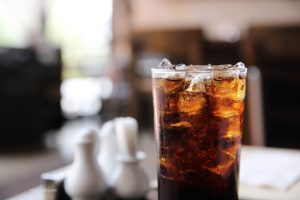A new study by Consumer Reports have found that caramel coloring is a potential carcinogen. That common ingredient is used most often in soft drinks, and in other foods to turn them brown.
 Two years ago, the Center for Science in the Public Interest said that ingredient should be declared a carcinogen and taken off the Generally Regarded as Safe (GRAS) list. Consumer Reports agrees. While “caramel coloring” sounds innocuous, it is a highly processed additive that contains a chemical called 4-methylimidazole (4-Mel). What’s interesting is that in the last two years, the amount of 4-Mel in products has dropped significantly. Manufacturers are paying attention to what consumers want.
Two years ago, the Center for Science in the Public Interest said that ingredient should be declared a carcinogen and taken off the Generally Regarded as Safe (GRAS) list. Consumer Reports agrees. While “caramel coloring” sounds innocuous, it is a highly processed additive that contains a chemical called 4-methylimidazole (4-Mel). What’s interesting is that in the last two years, the amount of 4-Mel in products has dropped significantly. Manufacturers are paying attention to what consumers want.
Under California’s Proposition 65 law, any food or beverage sold there that exposes consumers to more than 29 micrograms of 4-Mel per days has to carry a health warning label. New tests conducted by Consumer Reports found that 12 ounce samples of Pepsi One and Maita Goya had more than 29 micrograms per bottle. The group has asked the California Attorney General to investigate their findings.
Caramel color is the single most used food coloring in the world. Dr. Urvashi Rangan, toxicologist and executive director of Consumer Reports’ Food Safety and Sustainability Center said in a statement, “there’s no reason why consumers should be exposed to an avoidable and unnecessary risk that can stem from coloring food brown. Manufacturers have lower 4-Mel alternatives available to them. Ideally there would be no 4-Mel in food.” Making things even more problematic is that people often drink more than one can of colored pop a day. Even if there is less than 29 micrograms of 4-Mel in one can, it would be easy to exceed that amount on a hot day.
Consumers Reports tested 81 cans and bottles of various soft drinks from five manufacturers between April and September 2013 in the New York area and in California. They tested the products that had 29 micrograms of 4-Mel per can again in December 2013. In their initial testing, some brands in California had average levels around 29 micrograms per can, but the New York samples of the same brands tested much higher. In the second round, the samples purchased in New York were much lower, suggesting that the manufacturers may be reducing the levels when formulating the products.
Three brands – Coke, Diet Coke, and Coke Zero – had 5 micrograms per can. Sprite had none of the chemical. PepsiCo said that “reformulated products containing lower levels of 4-Mel would be available nationwide by February 2014.” Goya, the maker of Maita, did not respond to Consumer Reports’ questions.
Consumers should read labels carefully and avoid products that contain caramel color if they are concerned about this issue. You can tell the FDA about your opinion on this issue by visiting Consumer Union’s website.




